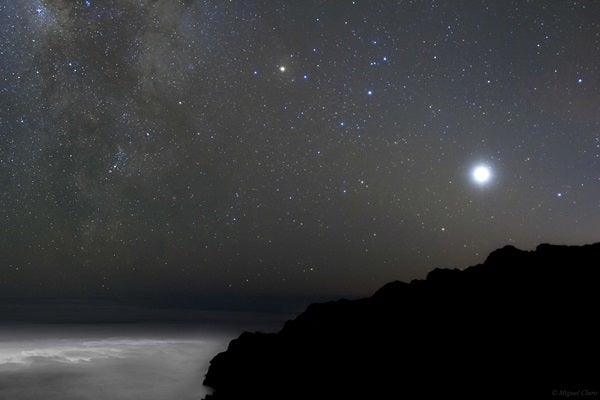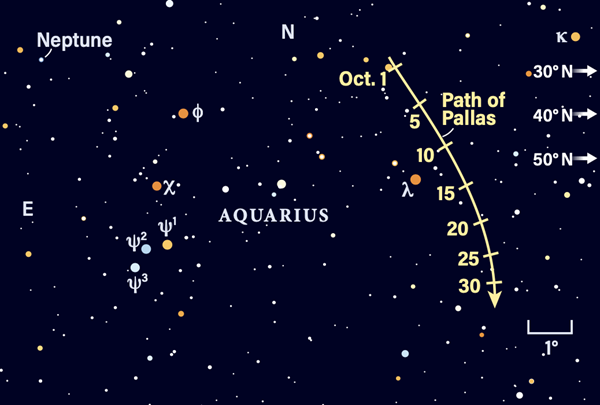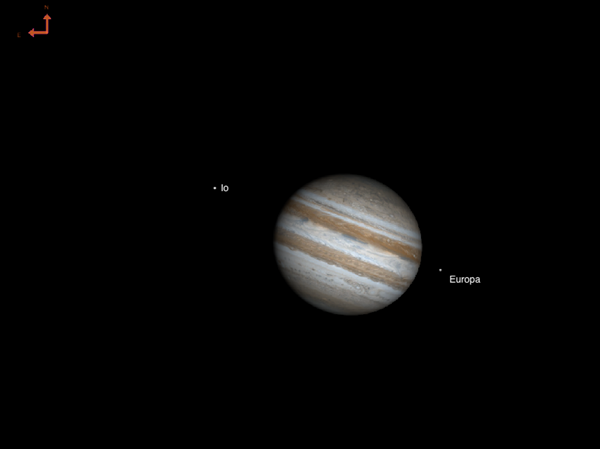Friday, October 1
The 66-mile-wide (107 kilometers) asteroid 40 Harmonia reaches opposition this afternoon at 3 P.M. EDT. You can find it in Cetus the Whale tonight, visible all evening and into the early morning hours of the 2nd.
An hour after sunset, look east, where magnitude 3.6 Iota (ι) Ceti is rising, already more than 6° high. Harmonia sits 7.7° east-northeast of this star. You can also use 5th-magnitude 20 Ceti as a jumping-off point: Harmonia is about 3.6° southwest of this luminary, roughly level with it in altitude as they rise. The longer you wait, the higher Harmonia will rise in the sky and the easier it will be to spot its magnitude 9.5 glow in binoculars or a small telescope.
Slightly brighter and also worth finding once Cetus has fully risen is the spiral galaxy M77, which shines at magnitude 8.9 a little less than 1° east-southeast of 4th-magnitude Delta (δ) Ceti. This face-on spiral has an actively feeding black hole at its center, earning it a classification as a Seyfert galaxy.
Sunrise: 6:57 A.M.
Sunset: 6:42 P.M.
Moonrise: 1:18 A.M.
Moonset: 4:34 P.M.
Moon Phase: Waning crescent (25%)
*Times for sunrise, sunset, moonrise, and moonset are given in local time from 40° N 90° W. The Moon’s illumination is given at 12 P.M. local time from the same location.
Saturday, October 2
A new month means it’s time to check out a new variable star. The American Association of Variable Star Observers’ featured variable of the month for October is Mira, also cataloged as Omicron (ο) Ceti.
If you looked for Harmonia last night, you already know that Cetus is rising in the east as the Sun sets in the west. Wait a few hours for it to get a bit higher, then look again for Delta Ceti. To its left (northeast) is bright Menkar, the Whale’s alpha star. And about the same distance to Delta’s right (southwest) is Mira.
This famous star has a name that translates to wonderful, so named by Polish astronomer Johannes Hevelius in the mid-1600s. It is the archetypical Mira variable, which is a type of variable star that changes brightness over about a year. Over the course of its 332-day period, Mira undergoes a vast change in visibility, growing as bright as 2nd magnitude and as faint as 10th magnitude. That’s a difference of some 1,600x in brightness! It also means Mira is only sometimes visible with the naked eye, while at other times it fades from view without the aid of binoculars.
Fortunately for us, Mira was last at its peak brightness in late August; by early September, it was magnitude 3. Even now, it’s still well within the range of naked-eye visibility. Once you’ve found it, see if you can determine Mira’s brightness by comparing it to the stars around it. Astronomy columnist Phil Harrington offers some tips and tricks for estimating this wonderful variable star’s brightness in his October 2020 Binocular Universe column, “The wonderful variable star.”
Sunrise: 6:58 A.M.
Sunset: 6:40 P.M.
Moonrise: 2:22 A.M.
Moonset: 5:09 P.M.
Moon Phase: Waning crescent (17%)
Sunday, October 3
Over in Aquarius the Water-bearer, asteroid 2 Pallas is slowly sliding southwest, diving south through the ecliptic, the plane of our solar system. Tonight, you’ll find the 9th-magnitude space rock 2.2° north of Hydor (Lambda [λ] Aquarii), which shines at magnitude 3.7. It’s in a region relatively rich with good anchor stars, so make a sketch or take a picture and come back over the next few nights to identify the asteroid’s motion through the field, while the background stars remain stationary.
Also hanging out in this watery constellation is Neptune, which now sits 8.8° east of Pallas and 3.8° northeast of 4th-magnitude Phi (ϕ) Aquarii. The solar system’s most distant planet is a faint magnitude 7.7 — too faint to see without binoculars or a telescope. Its disk currently spans about 2″ and appears a flat bluish-green if you can catch it on a steady night.
Sunrise: 6:59 A.M.
Sunset: 6:38 P.M.
Moonrise: 3:31 A.M.
Moonset: 5:40 P.M.
Moon Phase: Waning crescent (10%)
Monday, October 4
With such dark skies at our disposal, it’s time to hunt down a famous deep-sky object: M1, also known as the Crab Nebula.
Rising late in the evening, this target is best sought out in the few hours before sunrise, when the sky is at its darkest and Taurus, which houses this remnant of a once-massive star, is high in the southeast. M1 sits just 1.1° northwest of the Bull’s right (left on the sky) horn, marked by the bright star Alheka (Zeta [ζ] Tauri). You can find the Crab’s 8th-magnitude glow in binoculars, but a telescope will net you even more photons if you want a bit of an easier view.
Still, the Crab will likely look like a small gray smudge to the eye in even a medium-sized telescope. It comes out best when photographed, which will begin to show some of its intricate structure. But although it may not look like much without some work, the Crab came onto the scene with a bang — or, at least, a flash. Astronomers now know this cloud of stellar debris was left behind when a massive star exploded in a brilliant supernova, which was recorded by ancient astronomers in A.D. 1054. The so-called guest star reached magnitude –6 (brighter than Venus!), rendering it visible during the day and casting dim shadows at night. Recent work indicates it may be a unique kind of supernova called an electron-capture supernova, a class of stellar explosions theorized for decades but only confirmed earlier this year.
Sunrise: 7:00 A.M.
Sunset: 6:37 P.M.
Moonrise: 4:40 A.M.
Moonset: 6:08 P.M.
Moon Phase: Waning crescent (4%)
Tuesday, October 5
Jupiter’s moons are playing hide-and-seek tonight. Shortly after sunset, train your telescope on the bright gas giant, which now sits nearly 2° northwest of magnitude 2.9 Deneb Algedi in Capricornus.
At 9:48 P.M. EDT, Io slips out from behind Jupiter’s long shadow, reappearing about 20′ east of the planet’s limb. On the other side of the disk, Europa is closing in from the west; the icy moon slides out of sight behind the planet at 10:14 P.M. EDT. Jupiter’s other two large moons, Ganymede and Callisto, sit far off to the west, with Callisto currently farthest from the planet.
While you’ve got your telescope trained on Capricornus, swing over to the western side of the constellation, where Saturn sits a little less than 16° west of Jupiter. A dimmer 0.4 to Jupiter’s magnitude –2.7, Saturn nonetheless stands out in a telescope with its stunning ring system, which stretches roughly 40″ end to end. Saturn’s largest and brightest moon, Titan, is due north of the ringed planet tonight. You’ll find its magnitude 8.5 glow about 56″ north of the center of the planet’s disk.
Sunrise: 7:01 A.M.
Sunset: 6:35 P.M.
Moonrise: 5:51 A.M.
Moonset: 6:35 P.M.
Moon Phase: Waning crescent (1%)
Wednesday, October 6
New Moon occurs at 7:05 A.M. EDT, meaning our night sky will be completely dark and Moon-free. The Moon reaches this phase when it sits directly between Earth and the Sun so only its farside is illuminated, leaving its entire nearer face in shadow and hidden from our view. This is exactly the situation needed for a solar eclipse to occur, and sometimes it does. However, because the Moon’s orbit doesn’t exactly line up with the position of the Sun in the sky, not every New Moon causes a solar eclipse. (The next one will come before the end of the year, on December 4 — but it only touches land in Antarctica.)
Pluto is stationary at 9 A.M. EDT. If you have a large enough telescope, you can try finding this distant world after dark tonight. It’s located in Sagittarius, northeast of the Teapot asterism’s handle. The tiny dwarf planet, which glows at magnitude 15.2, sits within 7′ of a 7th-magnitude field star, HIP 97138. Pluto was previously moving southwest, but now it has reached a turnaround and will begin pulling away to the east-northeast as October progresses.
Sunrise: 7:02 A.M.
Sunset: 6:34 P.M.
Moonrise: 7:03 A.M.
Moonset: 7:02 P.M.
Moon Phase: New
Thursday, October 7
Venus crosses from Libra into Scorpius today. When you catch this evening star shortly after sunset tonight, you’ll see that its magnitude –4.3 glow is now 2.3° west of 2nd-magnitude Delta Scorpii, also called Dschubba. This star is one of three that make up the Scorpion’s head and its name means, appropriately, “the forehead.”
Venus itself is now 59 percent lit and 20″ across. It sets around 8:30 P.M. local time, so you should have a good while after sunset to observe it. Look farther to the planet’s east and you’ll run smack dab into 1st-magnitude Antares, Scorpius’ alpha star, whose red hue reveals that it is an aging red supergiant star whose color, as its name implies, rivals Mars.
The Red Planet itself reaches conjunction with the Sun at midnight EDT. Because it’s now on the opposite side of our star as Earth, the planet is not only invisible from our point of view, but it’s also harder for radio signals to reach it. That’s because emission from the Sun, which sits between our planets, can interfere with attempts to communicate between the two. So, NASA has announced it will refrain from sending commands to its fleet of martian missions until October 16, when conditions are more favorable. The missions are currently following preplanned programs, carrying out their orders autonomously until next week.
Don’t worry, though, Mars lovers — it will pull out of the Sun’s glare and reappear in the early morning skies by December.
Sunrise: 7:03 A.M.
Sunset: 6:32 P.M.
Moonrise: 8:17 A.M.
Moonset: 7:32 P.M.
Moon Phase: Waxing crescent (2%)
Friday, October 8
The Moon reaches perigee — the nearest point to Earth in its orbit — at 1:28 P.M. EDT. At that time, it will stand 225,797 miles (363,385 km) from our planet.
A second dwarf planet — this time 1 Ceres — reaches its stationary point this week. Magnitude 8 Ceres is stationary at 3 P.M. EDT, located in Taurus, which rises late this evening. Today, Ceres sits nearly 2.2° east of Aldebaran, the Bull’s brightest star. Like Antares, Aldebaran is a red giant star whose crimson hue is unmistakable.
Ceres is also 3° south of the open cluster NGC 1647, which contains about 90 suns at a distance of nearly 1,800 light-years. You can see this loose collection of stars with binoculars or a small scope — in fact, lower power is better for seeing more of this cluster, which spreads out over about 45′.
Sunrise: 7:04 A.M.
Sunset: 6:30 P.M.
Moonrise: 9:34 A.M.
Moonset: 8:04 P.M.
Moon Phase: Waxing crescent (7%)














